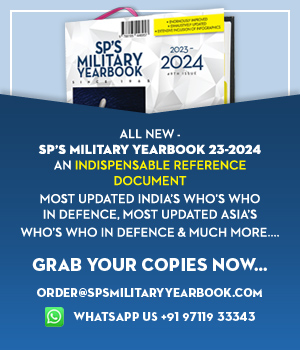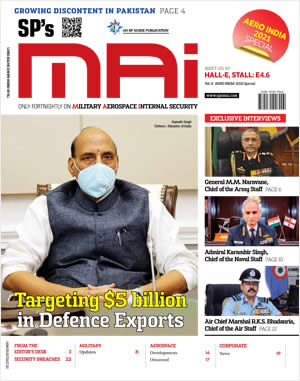INDIAN ARMED FORCES CHIEFS ON OUR RELENTLESS AND FOCUSED PUBLISHING EFFORTS
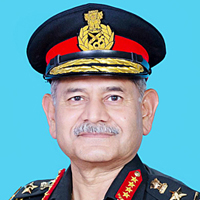
The insightful articles, inspiring narrations and analytical perspectives presented by the Editorial Team, establish an alluring connect with the reader. My compliments and best wishes to SP Guide Publications.
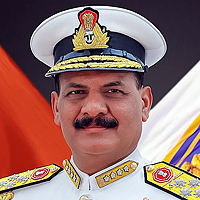
"Over the past 60 years, the growth of SP Guide Publications has mirrored the rising stature of Indian Navy. Its well-researched and informative magazines on Defence and Aerospace sector have served to shape an educated opinion of our military personnel, policy makers and the public alike. I wish SP's Publication team continued success, fair winds and following seas in all future endeavour!"

Since, its inception in 1964, SP Guide Publications has consistently demonstrated commitment to high-quality journalism in the aerospace and defence sectors, earning a well-deserved reputation as Asia's largest media house in this domain. I wish SP Guide Publications continued success in its pursuit of excellence.
- Prime Minister Modi Visits Punjab’s Adampur Air Base, Interacts with Airmen after Successful ‘Operation Sindoor’; Stern Message to Pakistan
- The layered Air Defence systems that worked superbly, the key element of Operation Sindoor
- Operation Sindoor | Day 2 DGMOs Briefing
- Operation Sindoor: India strikes back with Precision and Purpose
- Operation Sindoor: Resolute yet Restrained
- India’s Operation Sindoor Sends a Clear Message to Terror and the World – ‘ZERO TOLERANCE’
- Japan and India set forth a defence cooperation consultancy framework, talks on tank and jet engines
- Terrorist Attack in Pahalgam in Kashmir: Unfolding a long surgical war against PAK
- Lt General Pratik Sharma takes over Command of Indian Army's Northern Command
India–US Joint Working Group on Aircraft Carrier Technology Cooperation to progress on launch systems, EMALS
India and the US agree on plans to work on Aircraft Carrier technology cooperation, especially the launch systems of the aircraft, under the DTTI framework. However, it awaits any significant and tangible exchange under DTTI.
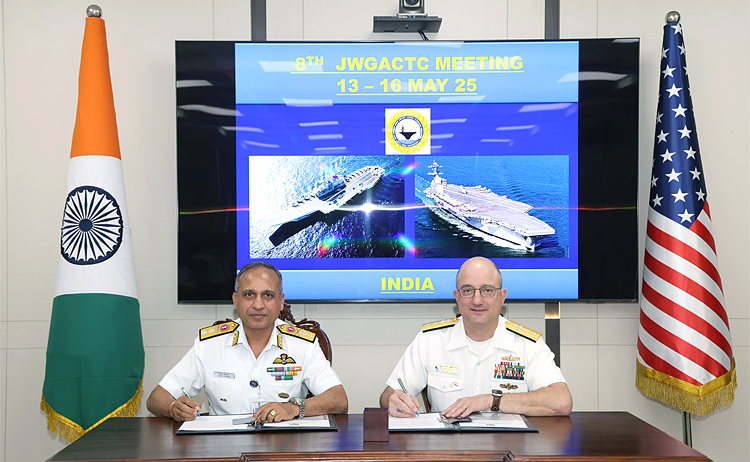
The 8th meeting of the India–US Joint Working Group on Aircraft Carrier Technology Cooperation (JWGACTC) was convened under the broader framework of the Defence Technology and Trade Initiative (DTTI) from May 13 to 16 May in New Delhi. A six-member US delegation headed by Rear Admiral Casey Moton, Programme Executive Officer (PEO), Aircraft Carriers, visited various defence establishments in Delhi and Goa. From India, the opening session of the Joint Working Group Meeting was co-chaired by Rear Admiral Vishal Bishnoi, Assistant Controller Carrier Projects (ACCP).
The high-level engagement marked a positive step forward in enhancing bilateral defence technology collaboration, particularly in aircraft carrier design, operations, and technological exchange.
The high-level engagement marked a positive step forward in enhancing bilateral defence technology collaboration, particularly in aircraft carrier design, operations, and technological exchange.
Senior officials from both nations' Ministries of Defence and Defence Departments, alongside representatives from naval commands, engineering corps, and defence research organisations, participated in the dialogue.
Key areas
India and the US reviewed the progress made since the 7th JWGACTC meeting in areas specific to advance cooperation on carrier design, construction technologies, and flight operations.
Earlier, DTTI had expanded on the possibilities to explore joint development opportunities, including the potential adoption of electromagnetic aircraft launch systems (EMALS) and advanced arresting gear.
A significant agenda item was continued discussion around the potential transfer or joint development of EMALS technology, a key enabler for launching heavier and more varied aircraft from carriers.
Further, they also explored the ways to deepen naval interoperability and mutual understanding of each nation's carrier operations doctrines.
However, the objective is to align priorities with broader DTTI goals of co-development and co-production. While no major outcomes have come so far, there is good progress on further technological insights into next-generation aircraft carriers.
EMALS for the Aircraft Carrier
Both sides reaffirmed their commitment to sharing best practices and technological insights relevant to next-generation aircraft carriers, including propulsion systems, deck design, and aviation integration.
A significant agenda item was continued discussion around the potential transfer or joint development of EMALS technology, a key enabler for launching heavier and more varied aircraft from carriers.
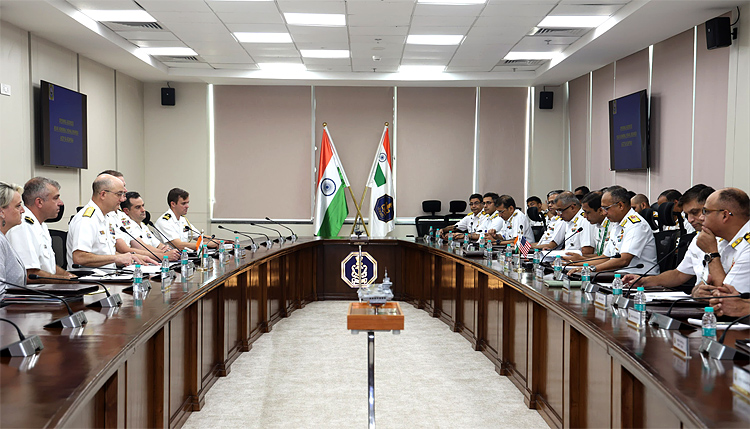
The US Navy provided technical briefings on EMALS and Advanced Arresting Gear (AAG). While no official words, it is also reported that nuclear propulsion considerations for carrier-based operations were also discussed.
Both sides agreed to establish a Technical Evaluation Group to assess the feasibility, timelines, and cost-effectiveness of EMALS integration into future Indian carriers.
The Indian Navy also presented its requirements and strategic vision for IAC-2 (Indigenous Aircraft Carrier 2), tentatively named INS Vishal, emphasising the need for advanced launch systems and modular construction.
The Indian Navy also presented its requirements and strategic vision for IAC-2 (Indigenous Aircraft Carrier 2), tentatively named INS Vishal, emphasising the need for advanced launch systems and modular construction.
The Indian Navy has two aircraft carriers – INS Vikramaditya, acquired from Russia, and the indigenously designed and built INS Vikrant. Both carriers deploy Russian-origin MiG-29K combat jets and use a ski-jump for launching aircraft unlike the several US carriers which use new-age system to launch -EMALS.
Training & maintenance
A proposal was accepted to enhance officer exchange programs, focusing on carrier operations, flight deck management, and maintenance of carrier-borne aircraft systems.
Opportunities for Indian Navy personnel to be embedded with US carrier task groups on a rotational basis were explored.
This meeting reflects a growing convergence in India–US defence interests, particularly in the Indo-Pacific maritime domain. The dialogue aligns with shared strategic objectives such as: Ensuring freedom of navigation and upholding a rules-based maritime order, and enhancing interoperability between the Indian Navy and US Navy.
The 8th JWGACTC meeting reinforced the strategic intent of India and the United States to move beyond traditional buyer-seller defence relationships and embrace a partnership model built on technology sharing, trust, and long-term capability building.
DTTI is also working under the mandate to promote co-development and co-production under the "Make in India" initiative, while leveraging US technological strengths.
While political will and strategic convergence remain strong, several challenges were acknowledged: The complexity of technology transfer protocols on the US side, including ITAR (International Traffic in Arms Regulations). The need to deliberate and act on the long-term technological and cost imperatives.
The requirement is to align industrial base capabilities in both countries for meaningful co-production.
The 8th JWGACTC meeting reinforced the strategic intent of India and the United States to move beyond traditional buyer-seller defence relationships and embrace a partnership model built on technology sharing, trust, and long-term capability building.
While the both parties agreed to meet again in six months to review progress and maintain momentum on deliverables, DTTI must look into the tangible outcome of such meetings.
As India plans its next generation of aircraft carriers, this cooperation may prove pivotal in shaping regional naval power dynamics and ensuring maritime stability in the Indo-Pacific.
Manish Kumar Jha is a Consulting & Contributing Editor for SP's Aviation, SP's Land Forces and SP's Naval Forces and a security expert. He writes on national security, military technology, strategic affairs & policies.




